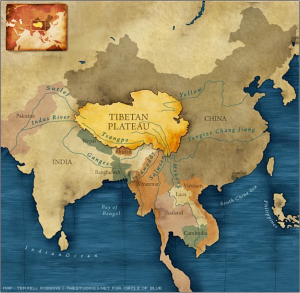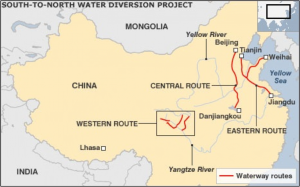Memo #110
(The first Memo from the Theme, Water, Scarcity, and Tibetan Plateau Frontiers)
By Tashi Tsering – ttsering [at] interchange.ubc.ca
 The prospect of China controlling the taps of Asia’s main rivers is a subject of intense debate. Downstream countries are understandably concerned. But Chinese experts say it is the Chinese who should be most worried about its government’s plans.
The prospect of China controlling the taps of Asia’s main rivers is a subject of intense debate. Downstream countries are understandably concerned. But Chinese experts say it is the Chinese who should be most worried about its government’s plans.
China is developing several large scale water development projects on the Tibetan Plateau, the source of major rivers including the Indus, Yangtze, Mekong, and Brahmaputra.
Among the most concerned downstream countries are India and Bangladesh, who fear that China might divert the Brahmaputra River. Chinese planners have long fantasized about diverting the river’s water to north China. Plans include using “peaceful nuclear explosions” and building a hydropower station with twice the generating capacity of the Three Gorges Dam. India has repeatedly raised the issue at bilateral talks and was met with China’s denial of having such plans.
The attention paid to the prospective diversion of the Brahmaputra, irrespective of the project’s feasibility, is predictable because of inter-state implications. But there is a tendency to overlook the larger context – a debate over alternative plans to divert water from the Tibetan Plateau to water scarce regions in northern China. The plan most likely to be implemented is the Western Route of the South-North Water Transfer Project (WR-SNWTP). It is a government approved project that will divert water from the upper reaches of the Yangtze River into the headwaters of the Yellow River.
The WR-SNWTP is equally noteworthy in terms of its engineering challenges. These include the presence of the Bayankala mountain range between the two rivers and the lower altitude of the source river system. Engineers may be able to solve these problems but Chinese scientists are more immediately concerned with the hydrology of the region as it is most sensitive to climate change.
Unlike the Brahmaputra diversion plan, which is a concern for downstream countries, the brunt of the WR-SNWTP will be borne by China’s own people. The WR-SNWTP will be built on important sources of the Yangtze River, which, according to the chief engineer of the Sichuan Geology and Mineral Bureau, are already facing drought crises due to overdevelopment.
About the Author:
Tashi Tsering – PhD candidate in Resource Management and Environmental Studies, The University of British Columbia. Guest Editor for Theme: “Water, Scarcity, and the Frontiers on the Tibetan Plateau“.
Links:
- Damming Tibet’s Yarlung Tsangpo-Brahmaputra and other South Asian Rivers, Tibetan Plateau blog, May 2010.
- China planning nuclear blasts to build giant hydro project, The Telegraph, October 2011.
- Diversion Debate, China Dialogue, June 2011.
- Climatic Features of Eco-Environment Change in the Source Regions of the Yangtze and Yellow Rivers in Recent 40 Years, Journal of Glaciology and Geocryology, January 2004.
- A Mighty River Runs Dry, Probe International, August 2011.
Related Memos:
- Cooperative Management of Mekong River is Crucial for 70 Million People (Memo #32, by Richard Paisley)
- Interview with Dai Qing, the Environmental Activist, Investigative Journalist, and Writer (Memo #39, Video Interview)

